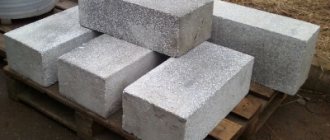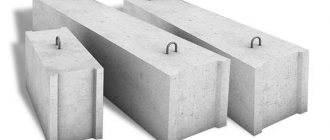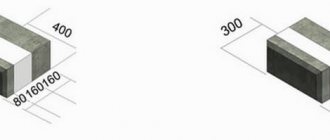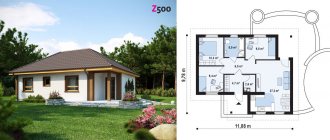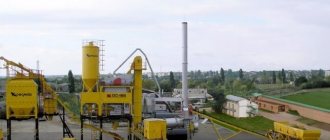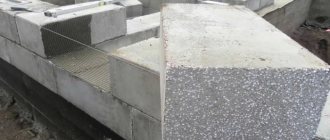The owner of a brick house a few decades ago was considered a fairly wealthy person with a high social status. The building, in the construction of which building blocks were used, was regarded as not prestigious, economical.
Inertia of thinking still remains, because although building blocks have changed dramatically and acquired a status at least equal to brick, name examples of the use of a block... Most usually immediately remember just unsightly cinder blocks, without really even thinking that they were made on modern equipment in compliance with geometric parameters and new technologies, they have now transformed, become more multifunctional and diverse. Let's look at what blocks exist for building a house, which ones are better and how much they cost.
Building blocks Source domishka-blog.ru
How to choose the right blocks for construction
When choosing blocks, you should focus on the specific purpose of the building or structure being erected: a permanent house, a cottage or summer house, an outbuilding or a garage.
Main criteria for selecting blocks for construction:
- the use of lighter weight building materials will allow significant savings on the foundation;
- the use of large blocks with good geometric characteristics significantly reduces time and labor costs for the construction of buildings;
- the correct choice of building materials for thermal insulation properties will avoid additional costs for insulation;
- Most types of building blocks do not require finishing work, which reduces overall costs and construction time.
Facial building blocks made of expanded clay concrete Source ro.decorexpro.com
Main technical parameters for choosing the right material:
- density;
- compressive strength;
- thermal conductivity;
- frost resistance;
- bending strength for earthquake-prone areas.
Wall building blocks Source beton-house.com
Sizes and selection rules
Dimensions of blocks for building a house
State standards standardize the dimensional parameters of blocks for wall masonry. Standardization helps to correctly calculate the volume of material. The list includes solid stones or blocks with holes for communications.
Dimensions of wall elements:
- expanded clay concrete stones, solid and hollow - 40x20x20 cm;
- gas silicate - 60x25x40 cm and 60x25x50 cm;
- foam concrete - 60x30x25 cm and 60x40x20 cm;
- polystyrene - 60x30x25 cm and 40x20x20 cm;
- wood concrete - 15x20x50 cm, 20x20x50 cm and 30x20x50 cm;
- ceramic - 25x12x6.5 cm, 25x12x14 cm, 25x25x14 cm, 51x9.5x22 cm.
When choosing materials, their cost and thermal conductivity, as well as labor costs for the construction of vertical structures, are taken into account. They take into account the need for insulation, waterproofing and decorative finishing, which will entail costs. What matters is the strength and load-bearing characteristics of the finished wall, its fire hazard, saturation with moisture and environmental cleanliness.
What are the building blocks?
Building blocks are a good alternative to other materials for constructing buildings, such as brick. Blocks are suitable for the construction of structures of any type and purpose, since they are larger in size than bricks, buildings from them can be erected faster.
Building blocks come in different types. To choose the right material for construction, you need to compare all the varieties and choose the best option based on the purpose of the block, its characteristics and quality.
All building blocks are divided into wall, partition and foundation.
Hollow building blocks Source kabel-house.ru
The main types of building blocks are:
- reinforced concrete;
- tongue-and-groove;
- expanded clay concrete;
- foam concrete;
- gas silicate.
This is not the entire list of building blocks; there are also adobe, cinder blocks, sawdust concrete products and others.
Cement blocks Source bettermetaltech.com
Earthbiting
Earth is the oldest building material. In Europe, building houses from earthen blocks is still quite popular today. This is caused not only by the fashion for ecological construction, but also by the unlimited service life of properly built houses made of earthen blocks, which over the years turn into the strongest concrete and do not shrink.
By adding straw or pine needles to the earth breaker, its thermal conductivity properties are significantly improved.
The most famous building made from this material is located in Russia. This is the Priory Palace in Gatchina.
Priory Palace in Gatchina Source xxx.artfile.ru
Original earthen house Source rumahku.com
Small round house made of earthenware Source stroysam.news
Adobe blocks
One of the varieties of earth breakers with identical technology for making blocks is considered to be adobe. Making adobe blocks is a fairly simple process, mostly done by hand. Water is added to the clay, the clay soil is kneaded and various components, mostly organic, are added to it.
Additives used:
- straw, firewood, manure, shavings - increase strength;
- crushed stone, sand, expanded clay - reduce shrinkage;
- cement, lime - accelerate hardening and increase moisture resistance;
- bone glue, casein, starch, molasses and other plasticizers.
The mixed components are stuffed into wooden formworks and dried naturally. As a result, after drying, adobe blocks are obtained; their dimensions are usually identical to cinder blocks: 40x20x20 cm.
Making adobe blocks Source domvpavlino.ru
Today, the technologies for making adobe blocks have been significantly improved, sometimes they are called clay concrete, clay fiber concrete.
Advantages of adobe house:
- The hygroscopicity of the building material creates a good microclimate in the house. Adobe acts as a humidity stabilizer; walls made of this material can replace air conditioners and humidifiers.
- An adobe house is always warm and cozy due to the thermal inertia of the material.
- Excellent soundproofing qualities of adobe walls.
- High fire resistance of building material.
- The aluminum contained in the clay gives the walls the properties of a protective screen from electromagnetic radiation.
- The price of adobe blocks is very affordable due to the low cost of raw materials.
Building a house from adobe Source pinterest.com
Disadvantages of housing made from adobe blocks:
- Low moisture resistance, the need for external protective finishing materials, at least lime whitewash.
- Organic fillers can lead to the appearance of unwanted insects and rodents in the walls; protective means and technologies are available, but this will lead to a slight increase in the cost of adobe blocks.
- It is necessary for the adobe to dry completely; in an under-dried state, the material loses all its advantages.
An adobe house with an original shape Source oooarsenal.ru
An adobe house, properly built and from high-quality materials, is reliable and durable in low-rise construction.
Historical examples can serve as clear evidence:
- tens of thousands of English adobe houses have remained decent and comfortable housing for more than five centuries;
- the earthen buildings of Jericho are usable after 9,000 years;
- houses in Yemen, built using adobe, 10 floors high, have been inhabited by people and have served them well for 900 years.
Can you be sure that houses made from modern super materials will last for so many years?
Shibam: Yemen's multi-story masterpiece Source mapio.net
See also: Catalog of companies that specialize in the design and construction of turnkey country houses.
Concrete blocks: foundation and wall
Products made from classical concrete are the only type of standardized blocks; all others are produced on the basis of technical specifications.
Cement, crushed stone, sand, water in various proportions to impart certain properties, voids are possible to reduce weight. The generally accepted dimensions of wall blocks (usually 390x190x190) - this is the general characteristic.
The price range for concrete blocks for building a house of standard size 390x190x190 is from 40 to 55 rubles, partition blocks 390x90x190 cost from 30 rubles. for 1 piece
The main use of concrete building blocks is the construction of foundations and load-bearing main walls.
Four-hollow wall concrete blocks Source festima.ru
The use of concrete blocks in the foundation significantly reduces the labor intensity of monolithic concreting and eliminates some technological processes, for example, the installation of formwork. Construction time is reduced both when constructing foundations and when replacing small-piece products (bricks) with blocks.
Foundation concrete blocks Source remdek.ru
cinder block
Slag is the material obtained after the combustion of solid fuel, mainly coal. Slag is an alloy of oxides. To be used as a raw material in the production of blocks, the slag must be kept in open areas for at least six months. Exposure to atmospheric precipitation allows you to naturally clean the slag from residual sulfur and phenol.
When producing cinder blocks, no additional chemical compounds are added.
Cinder block has two advantages over other wall stones: light weight and the lowest price in the wall block category, since slag is considered waste.
Types of cinder blocks Source banya-expert.com
The most common size is 390x190x190, it can have voids or be produced in a monolithic design, the average cost is around 35 rubles per piece.
Expanded clay block
Expanded clay concrete is a block made by vibrocompression, which contains: cement, sand, expanded clay, and water. Expanded clay has replaced slag in the composition of blocks, as it is an environmentally friendly, lightweight, inexpensive, accessible material.
An expanded clay concrete block made in industrial conditions has good geometric characteristics, different strength characteristics depending on the composition of the grade, which ranges from M25 to M100, and frost resistance from F15 to F100. The volumetric weight of expanded clay concrete block is from 800 kg/m3 to 1500 kg/m3.
Blocks that correspond in density to SNiPs have a smooth surface, do not require expensive finishing, and are quite consistent with the price-quality ratio.
Expanded clay concrete blocks Source domvpavlino.ru
Directions in which block production is carried out
Let's start with the fact that the material varies in composition.
At the moment, there are 2 general directions in the development of the concrete industry - the production of structures from heavy concrete and lightweight concrete blocks.
- Heavy concrete is widely presented in the form of FBS foundation sections . As well as structures used in road construction, such as concrete block B 5.
- Lightweight concrete blocks are available on the market in a wide variety of shapes and materials . But, in general, they are divided into wall, thermal insulation and partition structures.
Hollow blocks.
Important: structures made from lightweight compounds are divided into 2 main groups: hollow concrete blocks (having geometrically regular, designed cavities) and filled or monolithic ones.
Building blocks made of cellular concrete
Pore cells are formed in concrete as a result of foaming. This can be achieved in different ways, but the result is quite similar building materials: aerated concrete and foam concrete.
Building blocks made of cellular concrete Source emupauto.ru
Aerated concrete blocks
When aluminum powder is added to the building mixture and interacts with lime, a reaction occurs that resembles the fermentation of dough, as a result of which a porous structure is formed. The powder acts in the reaction as a gas-forming agent, and the resulting porous building material after hardening is called aerated concrete. The aerated concrete block gains strength in an autoclave.
The legislation does not require certification of aerated concrete blocks, but voluntary certification of those produced in a building materials plant is ubiquitous.
Construction from aerated concrete blocks Source interteam.com.ua
Dimensions of aerated concrete blocks:
- length – 600 mm;
- width – 250 mm;
- height – 100, 200, 250, 350, 450, 500 mm.
The blocks can withstand 100 freezing cycles.
Industrial production of aerated concrete began in 1929 in Sweden, in the USSR - in the 30s of the last century.
Aerated concrete blocks are connected using a special glue; this is facilitated by their ideal geometric shape with an error tolerance of no more than 2 mm. There are tongue-and-groove and smooth blocks, with a special recess for the hand.
The excellent heat-insulating properties of the gas block allow the house not to overheat even in hot weather.
Qualities of aerated concrete block Source nadoremont.com
Is it worth buying a cinder block?
From the name it is clear that the backfill of slag concrete is slag. As a rule, we are talking about blast furnace slag formed during the smelting of ore. Slag has a porous structure and does not conduct heat well enough.
Cinder blocks were widely used in Soviet times. It was a cheap material for creating various residential buildings. In those years there were practically no fakes, and the material was of good quality. Nowadays, it is important to carefully monitor what you buy. Cinder block production is quite expensive and there are a lot of fakes.
Today there is no slag in cinder blocks. It is replaced by broken glass, crushed stone, expanded clay, broken brick, etc. This is the same waste as slag. But all of the above is not blast furnace slag in the classical sense. The result is a material with unpredictable properties, low thermal conductivity and no guarantee of durability.
If you compare the characteristics of cinder blocks with other modern blocks, they will not impress anyone. Moreover, cinder block has high moisture absorption, 2 times more than foam block and gas block. It becomes extremely clear that cinder block under no circumstances can be called the best option for residential construction. Real blast furnace slag is expensive and difficult to find.
Video description
For more information about aerated concrete blocks, watch the video:
Gas blocks Source eurohouse.ua
Foam concrete blocks
Foam concrete in the Czech Republic is called “bioblocks”; it is extremely popular in Germany, Sweden, and Finland. In Russia, according to the most conservative estimates, there are approximately 1,200 foam concrete producers.
The difference between foam concrete and aerated concrete is that the former hardens under natural atmospheric conditions; otherwise, the characteristics of building materials are similar.
Foam concrete blocks Source kladka-penoblokov.ru
Advantages of aerated concrete building blocks:
- not flammable;
- does not rot;
- easy to process;
- has a wide range of sizes;
- does not mold;
- not afraid of water;
- relatively low price.
Advantages of foam concrete block Source pt.decoratex.biz
Disadvantages of aerated concrete building blocks:
- unstable density and weight;
- heterogeneity of pores due to the use of foam;
- a large number of uncontrolled producers.
In case of proper production and adherence to manufacturing technology, the properties of foam concrete are almost identical to aerated concrete, but the price of the latter is significantly higher.
House made of foam concrete Source remontik.org
Foam blocks
Foam blocks are made from foam concrete, which also belongs to the group of cellular concrete. This material is close in its parameters to aerated concrete, but its production technology is fundamentally different. Here the foam is not a product of a chemical reaction, but is added to the sand-cement mortar as a finished physical substance. The solution particles envelop the foam bubbles, harden and form a building material.
Production is simple and does not require the use of complex equipment. This was the reason for the appearance on the market of a large number of foam blocks, handicrafts produced by unknown craftsmen. They do not comply with GOST standards and cannot be used in the construction of critical structures, load-bearing walls, etc.
The advantages and disadvantages of foam blocks are almost the same as those of gas blocks. Externally they look neat and even. High-quality foam blocks should be gray in color. If they are white, it means that a lot of lime has been added to the solution. This reduces the strength of the material, so it is better not to buy such blocks.
Ceramic building blocks
Ceramic blocks, according to their production technology, are ceramic bricks of large volumes and attractive shapes. Ceramic blocks have excellent performance in all physical and chemical characteristics:
- good thermal efficiency;
- environmental friendliness;
- high sound insulation properties;
- ease of installation;
- suitable for performing any architectural and design tasks;
- does not require additional insulation;
- The blocks are laid using a special glue.
Ceramic blocks Source kamin-best.ru
Polystyrene concrete blocks
Building blocks made of polystyrene concrete are lightweight concrete using cement binder and foamed polystyrene as filler.
Advantages of polystyrene concrete building blocks:
- does not rot, does not mold;
- thermal conductivity is similar to wood;
- easy to process;
- a large selection of products of various shapes and sizes;
- light weight;
- high elasticity.
Advantages of polystyrene concrete block Source kassot.com
Disadvantages of polystyrene concrete building blocks:
- there is no data on the possible release of harmful substances during combustion;
- rapid destruction when exposed to ultraviolet radiation, additional timely protection is necessary;
- cold bridges appear at the junctions of blocks and lintels, window and door structures;
- long time to achieve design strength;
- significant shrinkage.
Polystyrene concrete block is produced in a classic form, in accordance with the requirements for building materials. It is used in the construction of non-load-bearing walls and partitions, for thermal insulation and sound insulation.
Polystyrene concrete block Source brick-66.ru
Heat blocks
Combined type blocks are gaining popularity, for example, heat block, heat wall, polyblock, porotherm.
Manufacturers declare heat blocks and its analogues as an ideal solution not only as the main wall material. Heat blocks are considered universal, made in the form of a multi-layer cake with additional insulation properties.
Heat block Source bizorg.su
In addition, heat blocks can be used as a decorative material for external and internal use.
Permanent formwork blocks
Small-piece blocks used as permanent formwork can, to some extent, also be classified as building blocks.
When using them, it is possible that better performance is possible in comparison with traditional blocks, but the share of permanent formwork materials in construction is still small, there are technological difficulties in using them, and their effectiveness has not yet been confirmed in practice.
Main brands and brands: Simprolit, Izodom, Durisol, Thermoblock, Mosstroy-31.
Permanent formwork blocks Source ko.decorexpro.com
Making at home
To produce reinforced concrete blocks with your own hands, you will need Portland cement, sand with a fraction of at least 1.5 millimeters and water. In this way, wall, ventilation, and partition blocks can be made. The composition and proportions of the solution depend on what binder is used and usually coincide with the standard ones.
By mixing the solution, you achieve the desired consistency: it is advisable that it is not liquid, as this reduces the level of strength of the final product. The work uses a vibration installation, thanks to which it is possible to distribute the solution in the molds more efficiently and evenly.
You can make molds from various materials of suitable sizes yourself or buy ready-made ones (the sizes are different, as are the configurations). The solution is poured into the molds as tightly as possible, paying special attention to the ends and corners.
Next, the composition is vibrated or compacted, and the top is leveled with a trowel. If the block is reinforced, then metal mesh is installed inside the form.
The form must dry for at least three days, during which the solution will harden. Then they disassemble the structure, take out the section, and allow it to dry for at least 21 days. Only after this the blocks can be used in construction.


